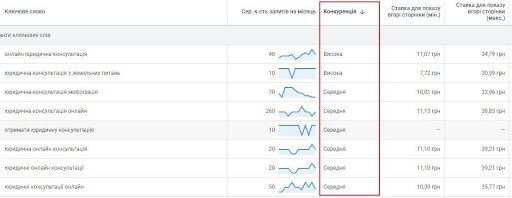Content
- 1 Main factors influencing the cost of contextual advertising
- 2 Cost per click (CPC) or cost per impression (CPM)?
- 3 Budget optimization strategies for contextual advertising
- 4 Is it possible to influence the cost of contextual advertising?
- 5 Ways to increase the effectiveness of contextual advertising
- 6 Budget calculation
- 7 What results can contextual advertising give
- 8 How much does it cost to set up and support Google contextual advertising in our company?
- 9 FAQ
Main factors influencing the cost of contextual advertising
The cost of contextual advertising in Google Ads is determined by a number of key factors.
- Keywords: Cost often depends on competition for keywords. The more popular and competitive the keyword, the higher the cost per click.

- Ad quality and relevance: Relevant and well-written ads can reduce cost per click, as search engines tend to reward a good user experience.
- Target audience and geography: the cost may vary depending on the geographic location and characteristics of the target audience. For example, ads targeting large cities or specific demographic groups may cost more.
- Time of day and day of the week: advertising costs may vary depending on the time of day and days of the week. During peak hours or on certain days, the cost per click may be higher due to increased demand.
- Budget and bidding strategy: The overall budget and the bidding strategy you choose also affect the cost. For example, setting high CPC bids may increase the likelihood of your ad being shown, but will also increase the overall cost of the campaign.
Cost per click (CPC) or cost per impression (CPM)?
The choice between pay-per-click (CPC) and pay-per-impression (CPM) depends on the goals of the advertising campaign and the specifics of the market. CPC is better suited for campaigns aimed at driving user action (such as a purchase or registration) because you only pay per click, making costs more predictable and tied to specific actions. At the same time, CPM is more effective for increasing brand or product awareness, as it allows you to guarantee advertising to a large number of people for a fixed amount, which is especially important when working with a wide audience.

How does pay-per-click work?
The pay-per-click (CPC, Cost Per Click) model is one of the main forms of payment in Google contextual advertising. In this model, the advertiser pays for each click on his ad. The central aspect here is the cost per click, which depends on a number of factors.
First, CPC is determined based on an auction where advertisers bid on keywords. Highly competitive keywords typically have a higher cost-per-click due to more advertisers willing to pay to drive traffic to those queries. On the other hand, less competitive keywords may cost less.
Secondly, Google takes into account the quality and relevance of the ad in relation to the keyword. High quality ad and its relevance to the search query can reduce the cost per click. This means that if an ad closely matches a user’s query and has a high level of quality, Google may be able to provide a lower cost per click, even if competition is high.
How does pay-per-impression work?
The cost-per-impression model (CPM) is another popular payment method in contextual advertising, including platforms such as Google Ads and Meta. In this model, the advertiser pays for every thousand impressions of his ad, regardless of whether users click on the ad or not.
The main idea of CPM is to ensure brand visibility and recognition. This makes the model especially attractive for large campaigns aimed at raising brand consciousness or reaching a wide audience.
The cost per impression in this model can also vary depending on several factors. The first is the target audience: advertising aimed at high-income or specialized market segments may cost more due to the greater value of these audiences to advertisers. Second, geographic location and timing can play a role in determining cost. For example, advertising in major cities or during prime time may be more expensive due to increased demand and competition.
Which is more profitable?
Let’s do the math for two hypothetical examples to see which would be more profitable: cost-per-click (CPC) or cost-per-impression (CPM).
Example No. 1
Impressions: 20,000
Clicks: 15
Click price: $0.5
CPC cost (cost per click): 15 clicks × $0.5/click = $7.5
Let’s say the cost per 1000 impressions (CPM) is $1.
Then: cost at CPM (cost per impression): (20,000 impressions / 1000) × $1 = $20
Conclusion: In this case, it is more profitable to choose pay-per-click (CPC), since the cost will be $7.5 instead of $20.
Example No. 2
Impressions: 15,000
Clicks: 500
Click price: $0.5
CPC cost (cost per click): 500 clicks × $0.5/click = $250
Assume that the cost per 1000 impressions (CPM) is also $1.
Then: cost at CPM (cost per impression): (15,000 impressions / 1000) × $1 = $15
Conclusion: In the second case, it is much more profitable to use cost per impression (CPM), since the costs will be $15 versus $250 when using CPC.
These examples show that the choice between CPC and CPM should be based on the specific results of the advertising campaign, including the ratio of impressions to clicks and the cost of each of these parameters.
As a result, the choice between CPC and CPM should be based on the strategic goals of the advertising campaign and an understanding of the target audience. For campaigns that target specific actions or results, CPC may be more effective. In cases where reach and awareness are most important, CPM may be preferable.

Budget optimization strategies for contextual advertising
The role of quality and relevance in contextual advertising
Quality and relevance are key factors for success in contextual advertising, including advertising in Google Ads. Ad quality refers to its ability to grab the attention of the target audience, provide valuable information, and lead to a desired action, such as a click or purchase.
An ad’s relevance, on the other hand, refers to its relevance to users’ needs and interests. Google uses a complex algorithm that evaluates these two aspects to determine ad ranking and cost per click. High quality and relevance not only reduce the cost of a click, but also increase the likelihood of receiving a click, thereby increasing the overall effectiveness of the campaign. Therefore, it is important to carefully work on the text of the ad, its visual design and compliance of the offer with the needs of the target audience.
Using geotargeting to improve advertising effectiveness
Geotargeting is a powerful tool in contextual advertising that allows you to target ads to audiences in specific geographic areas. This method is especially useful for businesses that target customers in specific regions, cities, or even neighborhoods. By using geotargeting, companies can increase the relevance of their ads by showing them to users for whom they are most relevant.
For example, a local restaurant could set up an ad to only show to users within a certain distance of the establishment. This approach not only increases the likelihood of a response to an ad, but also optimizes the advertising budget, excluding impressions to users outside the target geography. Geotargeting also allows you to tailor the messages in your ads to specific regional characteristics, which increases their effectiveness.
Analysis of competition and its impact on price
Competition analysis plays an important role in determining the strategy and cost of contextual advertising. In the Google Ads environment, competition for keywords directly affects the cost of advertising bids. When multiple advertisers seek to reach audiences for the same or similar keywords, the cost per click (CPC) for those keywords increases. This is due to the Google Ads auction mechanism, where advertisers bid to position their ads in search results.
In addition, competition analysis helps you understand which ads are more effective. By studying competitors’ advertising messages, their offers and targeting features, you can identify the strengths and weaknesses of both your advertising strategy and that of your competitors. This allows you to optimize your own advertising campaigns, making them more attractive and relevant to the target audience, which can ultimately reduce the overall cost of customer acquisition.
Is it possible to influence the cost of contextual advertising?
Features of managing an advertising budget
Effective management of the advertising budget in contextual advertising Google Ads is a key factor in the success of advertising campaigns. Determining the optimal budget requires understanding your campaign goals, audience, and level of keyword competition. It is important to set realistic budget limits that fit both your marketing goals and your company’s financial capabilities.
Advertisers should also consider seasonality and market trends, which can affect the effectiveness and cost of advertising. In addition, it is important to constantly monitor the effectiveness of advertising campaigns and adjust the budget in accordance with the received data on conversions, clicks and other key indicators. This helps optimize costs and improve ROI (return on investment) of advertising campaigns.
Features of bid adjustment
Adjusting bids in contextual advertising, especially in Google Ads, is an important part of managing advertising campaigns. Rates may be adjusted based on various factors such as time of day, day of week, geographic location, and user device type. For example, if data analysis shows that more conversions occur during certain hours or days, bids can be raised during those periods to increase ad visibility.
It can also be useful to increase bids for mobile users if analysis shows they are more likely to convert. On the other hand, rates may be reduced in cases where data indicates poor performance. Bid adjustments require ongoing analysis and testing to determine the optimal parameters for each campaign. This helps maximize results at minimal cost, increasing the overall effectiveness of your advertising budget.
Ways to increase the effectiveness of contextual advertising
External factors
In the context of increasing the effectiveness of contextual advertising, external factors play a significant role. This includes market trends, competitor behavior, changes in search engine algorithms, and seasonal fluctuations in demand.
For example, increased competition for certain keywords may increase the cost per click. Seasonality affects the interests and behavior of the target audience, which should be taken into account when planning campaigns and budgets. Also, changes in search engine algorithms can affect the visibility and effectiveness of advertisements.
Successful advertisers constantly analyze the external environment and adapt their strategies to remain competitive and achieve maximum return on advertising investment.
Internal factors
Internal factors influencing the effectiveness of contextual advertising include elements that the advertiser can control and optimize. This concerns the quality and relevance of advertising materials, the structure of advertising campaigns, the selection and customization of the target audience, as well as the effectiveness of landing pages.
For example, a clearly defined target audience and well-tailored targeting help increase ad relevance, which can lead to higher engagement and conversion rates. It’s also important to regularly analyze and test various ad elements, including headlines, descriptions and visuals, to improve their appeal and effectiveness. On-page optimization also includes monitoring and analyzing the results of advertising campaigns to continuously improve the strategy and achieve better results at minimal cost.
Budget calculation
Budget and traffic forecast by context
Forecasting budget and traffic in contextual advertising is an important step in planning advertising campaigns. This process involves analyzing potential advertising costs and estimating the expected traffic that can be attracted based on the keywords and bids chosen. To understand how to calculate the most effective budget for your campaign, it is important to consider not only current market conditions, but also analyze past trends and results.
To make effective forecasts, advertisers must consider various parameters, including the average cost per click (CPC) of target keywords, the level of competition, and historical data from past advertising campaigns. In addition, it is important to take into account seasonal fluctuations in demand and the behavior of the target audience, which can significantly affect the effectiveness and cost of advertising. Using tools such as Google Ads Keyword Planner can help gather the information you need and creating more accurate forecasts.
Budget calculation in KMS
Calculating a budget for Google’s Display Network involves determining the amount of money that will be spent on displaying advertisements on Google’s wide network of partner sites. Unlike search advertising, display advertising is aimed at users who may not be looking for specific products or services, but may be interested in them.
When calculating your display media budget, it is important to consider the goals of the advertising campaign, the target audience and the context in which the ads will be displayed. The budget may vary depending on the planned coverage, selected website topics and advertising formats. It is also important to consider the specifics of the audience and its needs, as this affects the engagement and effectiveness of advertising. Calculating the budget in the CMS requires a flexible approach and a willingness to adjust the strategy depending on the results obtained and performance indicators.
What results can contextual advertising give
Contextual advertising can bring a wide range of results that significantly influence the success of a business. One of the key benefits is increasing the visibility of the brand and its products among the target audience. Effectively configured campaigns help attract quality traffic to the site, which leads to an increase in the number of inquiries, orders and sales. Contextual advertising also helps to quickly attract attention to new products or services, promotions and special offers. With the right approach and constant optimization, PPC advertising can provide a high ROI (return on investment), making it one of the most effective tools in your digital marketing arsenal.
How much does it cost to set up and support Google contextual advertising in our company?
The cost of services for setting up and maintaining contextual advertising in Google Ads varies depending on many factors, including the complexity of the campaign, the number of keywords, the competitiveness of the niche, and the required level of specialist involvement. The cost is also influenced by the individual needs of the business, the goals of the advertising campaign and the size of the target audience. At our company, we offer flexible rates that are suitable for both small businesses with a limited budget and large companies with extensive advertising campaigns. We strive to provide the most effective solutions, combining quality service with optimization of advertising costs. Order contextual advertising with maximum return on investment by filling out the form, we will make a detailed calculation.
Conclusions
In conclusion, Google Ads is a powerful tool in the digital marketing arsenal that can deliver significant business results. A properly configured and optimized campaign helps increase brand visibility, attract target audiences and increase sales. However, achieving these results requires a professional approach to planning and managing advertising campaigns. Investments in qualified services for setting up and supporting contextual advertising pay off by increasing the effectiveness of advertising campaigns and achieving higher ROI.
FAQ
What affects the price of contextual advertising?
The price of contextual advertising depends on many factors: keyword competition (the more advertisers compete for a certain keyword, the higher the cost), the quality of the advertisement and the corresponding page to which it leads (high quality can reduce the cost per click). Geographic targeting, advertising format and timing of placement are also important. Demand and seasonality also play a significant role, as does the choice of advertising platform.
What is CTR in context?
CTR, or click-through rate, is the percentage ratio between the number of clicks on an ad and the number of times that ad is shown. This is a key indicator of advertising effectiveness in context. CTR is calculated as the ratio of clicks to impressions multiplied by 100%. A high CTR indicates that the advertisement is interesting to the target audience and effectively attracts attention.
How to increase CTR?
To increase CTR, it is important to focus on several aspects: you should optimize the ad text, making it attractive and relevant to the target audience; use keywords in ads and calls to action (CTAs). Targeting settings help you reach more relevant audiences. In addition, regular analysis and testing of different versions of ads allows you to identify the most effective approaches and improve results.

Expert in legal marketing. Head of marketing agency MAVR.
Business degree “Master of Business Administration” (MBA).
